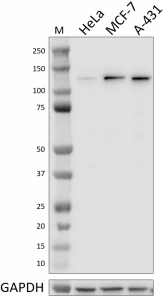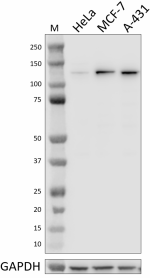- Clone
- W20162C (See other available formats)
- Regulatory Status
- RUO
- Other Names
- DNA repair protein complementing XP-C cells (XPC), Xeroderma pigmentosum complementation group C (XPC), p125, XPC-Complex Subunit
- Isotype
- Rat IgG2b, λ
- Ave. Rating
- Submit a Review
- Product Citations
- publications

-

Whole cell extracts (15 µg total protein) from the indicated cell lines were resolved by 4-12% Bis-Tris gel electrophoresis, transferred to a PVDF membrane, and probed with 1.0 μg/mL of purified anti-XPC (clone W20162C) overnight at 4°C. Proteins were visualized by chemiluminescence detection using HRP goat anti-rat IgG (Cat. No. 405405) at a 1:3000 dilution. Direct-Blot™ HRP anti-GAPDH (Cat. No. 607904) was used as a loading control at a 1:25000 dilution. Lane M: Molecular weight marker
| Cat # | Size | Price | Quantity Check Availability | Save | ||
|---|---|---|---|---|---|---|
| 604851 | 25 µg | 118 CHF | ||||
| 604852 | 100 µg | 335 CHF | ||||
XPC is a protein involved in the nucleotide excision repair (NER) pathway, a mechanism that repairs single-stranded DNA damage. XPC is a member of the XPC complex that recognizes DNA damage resulting in thermodynamically unstable DNA structures. For example, the unstable structures caused by the damage from ultraviolet light. XPC-RAD23B activation recruits other NER pathway members to the site and promotes progression through NER. XPC mutations can result in the disease that is the protein’s namesake, Xeroderma pigmentosum, characterized by an extreme sensitivity to sunlight and high cancer risk. More broadly speaking, since DNA damage underlies many types of cancer, changes in XPC expression levels or mutations in XPC are often found in tumors.
Product DetailsProduct Details
- Verified Reactivity
- Human
- Antibody Type
- Monoclonal
- Host Species
- Rat
- Immunogen
- Recombinant fragment of human XPC
- Formulation
- Phosphate-buffered solution, pH 7.2, containing 0.09% sodium azide
- Preparation
- The antibody was purified by affinity chromatography.
- Concentration
- 0.5 mg/mL
- Storage & Handling
- The antibody solution should be stored undiluted between 2°C and 8°C.
- Application
-
WB - Quality tested
- Recommended Usage
-
Each lot of this antibody is quality control tested by western blotting. For western blotting, the suggested use of this reagent is 0.25 - 1.0 µg/mL. It is recommended that the reagent be titrated for optimal performance for each application.
- Application Notes
-
This product does not cross-react with mouse by WB.
This product is not recommended for ICC and IHC-P. - RRID
-
AB_2924610 (BioLegend Cat. No. 604851)
AB_2924610 (BioLegend Cat. No. 604852)
Antigen Details
- Structure
- XPC is a 940 amino-acid protein with a predicted molecular weight of 106 kD.
- Distribution
-
XPC is expressed in most mammalian cells, shuttling between the nucleus and cytoplasm in the absence of DNA damage.
- Function
- XPC binds DNA in the presence of DNA damage
- Interaction
- XPC forms the XPC complex along with RAD23B and CETN2
- Biology Area
- Cell Biology, Cell Cycle/DNA Replication, Cell Proliferation and Viability, DNA Repair/Replication
- Molecular Family
- Nuclear Markers
- Antigen References
-
- Nezow L, et al. 2015. DNA Repair. 26:19-27.
- Sugasawa K, 2008. Adv Exp Med Biol. 637:47-56.
- Gene ID
- 7508 View all products for this Gene ID
- UniProt
- View information about XPC1 on UniProt.org
Related Pages & Pathways
Pages
Related FAQs
Other Formats
View All XPC1 Reagents Request Custom Conjugation| Description | Clone | Applications |
|---|---|---|
| Purified anti-XPC | W20162C | WB |
Compare Data Across All Formats
This data display is provided for general comparisons between formats.
Your actual data may vary due to variations in samples, target cells, instruments and their settings, staining conditions, and other factors.
If you need assistance with selecting the best format contact our expert technical support team.
-
Purified anti-XPC

Whole cell extracts (15 µg total protein) from the indicated...

 Login / Register
Login / Register 







Follow Us